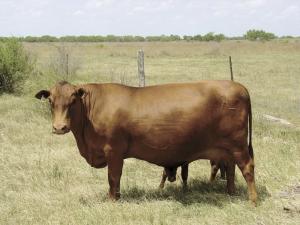New STAR Cattle Breed Shines During Droughts
 ✖  |
During the worst summer heat in south Texas, Steven Lukefahr’s cattle herd continues to graze, while many of his neighbors’ cows seek shade. Years of drought and disappointment with other breeds led the genetics researcher and professor of animal science at Texas A&M to develop the STAR cattle breed. Combined with smart pasture management, he is able to keep cows fed for $30 to $40/each per year.
STAR stands for the breed’s genetics, which comes from heat-tolerant breeds, Senepol and Tuli (African breeds), combined with Red Angus. Lukefahr chose the red cattle because of their lighter color, which absorbs less heat. The African breeds have glossy coats and numerous skin folds that help them sweat and keep them cooler.
“They spend more time eating grass during hot days than seeking shade,” Lukefahr says.
Smaller in size, at about 1,000 to 1,100 lbs., they are more efficient, he says. They don’t make excessive milk nor have the expensive feed requirements of larger cattle he owned in the past. The mothers are gentle and low maintenance. Early puberty – as early as 5 to 7 mos. – means they have gone through several heat cycles when they reach 15 mos. to improve breeding odds. They finish out at 18 mos. on grass, and steers have carcass traits that compare to purebred Angus, according to USDA studies.
While all those characteristics are important, Lukefahr emphasizes that the STAR breed’s ability to thrive on poor grass during drought is what makes them shine. Pasture management is also crucial.
“Flexibility is key in working with nature,” says Lukefahr. “My focus every year is on planning for drought.”
He uses rotational grazing, and when grass isn’t coming back due to the drought he sells some cattle or leases additional land. Recently, when rains finally came after a long drought, his pastures returned in abundance while other pastures had nothing left to green up. He breeds his cows to calve in May so that weaning comes later after fall rains when there is plenty of grass to restore the body condition of his cows. The weaned calves weigh about 600 lbs.
Lukefahr used both AI and natural breeding to create the STAR breed, aiming for genetics that are at least half Senepol and Tuli. He sells breeding bulls for $1,500 to $2,000. Other animals are sold to be finished on grass. The cattle grow a winter coat to work well in colder climates, he adds. The furthest north he’s sold them at this point is Missouri.
His website includes photos and information of animals available for sale.
Contact: FARM SHOW Followup, Steven D. Lukefahr, 195 FM 772E, Kingsville, Texas (ph 361 219-0382; slukefahr@gmail.com; www.lukefahr-ranch.com).

Click here to download page story appeared in.
Click here to read entire issue
New STAR Cattle Breed Shines During Droughts LIVESTOCK Beef During the worst summer heat in south Texas Steven Lukefahr’s cattle herd continues to graze while many of his neighbors’ cows seek shade Years of drought and disappointment with other breeds led the genetics researcher and professor of animal science at Texas A&M to develop the STAR cattle breed Combined with smart pasture management he is able to keep cows fed for $30 to $40/each per year STAR stands for the breed’s genetics which comes from heat-tolerant breeds Senepol and Tuli African breeds combined with Red Angus Lukefahr chose the red cattle because of their lighter color which absorbs less heat The African breeds have glossy coats and numerous skin folds that help them sweat and keep them cooler “They spend more time eating grass during hot days than seeking shade ” Lukefahr says Smaller in size at about 1 000 to 1 100 lbs they are more efficient he says They don’t make excessive milk nor have the expensive feed requirements of larger cattle he owned in the past The mothers are gentle and low maintenance Early puberty – as early as 5 to 7 mos – means they have gone through several heat cycles when they reach 15 mos to improve breeding odds They finish out at 18 mos on grass and steers have carcass traits that compare to purebred Angus according to USDA studies While all those characteristics are important Lukefahr emphasizes that the STAR breed’s ability to thrive on poor grass during drought is what makes them shine Pasture management is also crucial “Flexibility is key in working with nature ” says Lukefahr “My focus every year is on planning for drought ” He uses rotational grazing and when grass isn’t coming back due to the drought he sells some cattle or leases additional land Recently when rains finally came after a long drought his pastures returned in abundance while other pastures had nothing left to green up He breeds his cows to calve in May so that weaning comes later after fall rains when there is plenty of grass to restore the body condition of his cows The weaned calves weigh about 600 lbs Lukefahr used both AI and natural breeding to create the STAR breed aiming for genetics that are at least half Senepol and Tuli He sells breeding bulls for $1 500 to $2 000 Other animals are sold to be finished on grass The cattle grow a winter coat to work well in colder climates he adds The furthest north he’s sold them at this point is Missouri His website includes photos and information of animals available for sale Contact: FARM SHOW Followup Steven D Lukefahr 195 FM 772E Kingsville Texas ph 361 219-0382; slukefahr@gmail com; www lukefahr-ranch com
To read the rest of this story, download this issue below or click
here to register with your account number.







